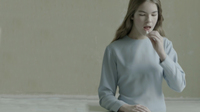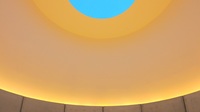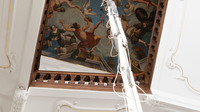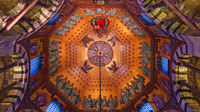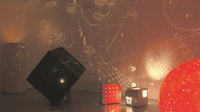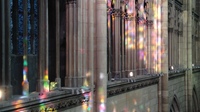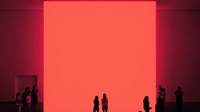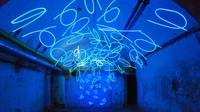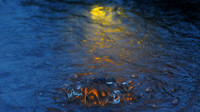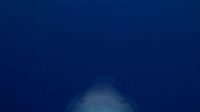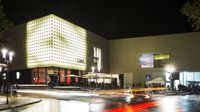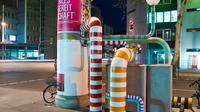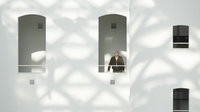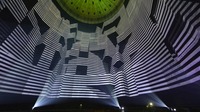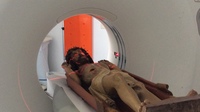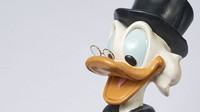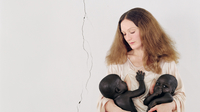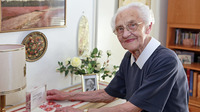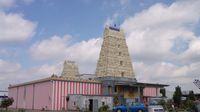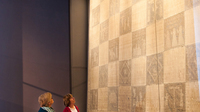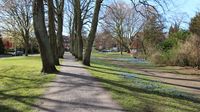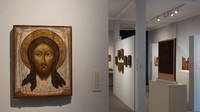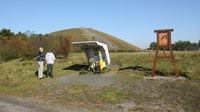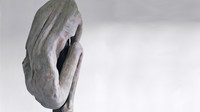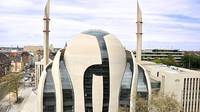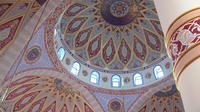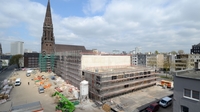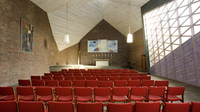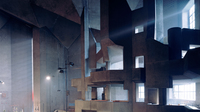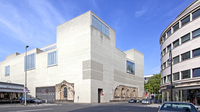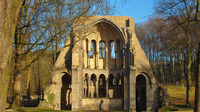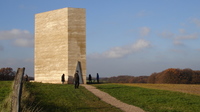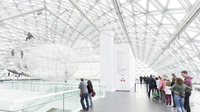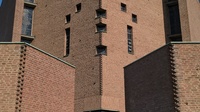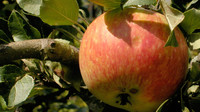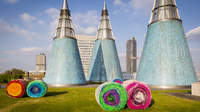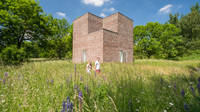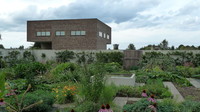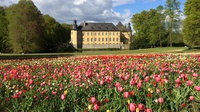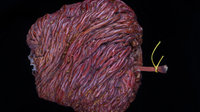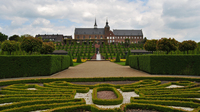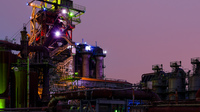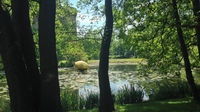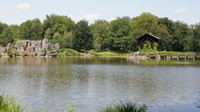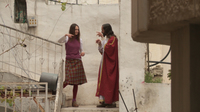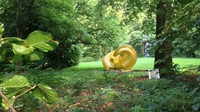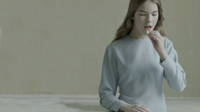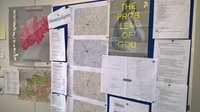#Artpilgrimage in NRW

Discover paradisal gardens and small art epiphanies, stories of lived folk beliefs, and modern interpretations of church architecture on four travel routes: The exhibition The Problem of God in K21 Ständehaus, organized by the Kunstsammlung Nordrhein-Westfalen, reflects critically on the “resurgence of the religious” and Christian imagery in contemporary art. Shows in all of North Rhine-Westphalia illustrate the topicality of the subject as well: That’s why we invite you to take an #Artpilgrimage in NRW.
#Artpilgrimage in NRW Light

And God said, "Let there be light," and there was light. Artists too use the ephemeral material of light creatively. Whether for spiritual reasons or out of sensory curiosity: North Rhine-Westphalia is a place of pilgrimage for followers of this young art movement, seeking out the work of the Düsseldorf group Zero, the luminous art of the Ruhr Area pitheads, and the window by Gerhard Richter in Cologne. Unique worldwide is also the Center for International Light Art in Unna. Here, at the very latest, you will experience moments of artistic enlightenment on your #Artpilgrimage.
#Artpilgrimage into the Light: Aachen Kunst aus NRW

Light art as idolatry or as an expression of the sacred? Entering the stairwell of the former Imperial Abbey of Aachen-Kornelimünster, you are welcomed by Martin Pfeifle’s neon tubes suspended below a ceiling painting illustrating the fall of the ancient gods at the hands of Archangel Michael. The museum Kunst aus NRW presents art made in NRW since 1945—from the light art of the Zero pioneers to contemporary photographs by Andreas Thein who shoots boxes, drawers, and wardrobes, their dark interior concealing sacred objects.
#Artpilgrimage into the Light: Aachen Aachen Cathedral

This glowing miracle and Germany’s first UNESCO world heritage site is certainly not contemporary. But looking high up into the dome of the octagon, into the light that falls through the leaded windows onto the Shrine of Charlemagne and onto the myriad details of the magnificent Byzantinesque mosaics is a must for every (light) art enthusiast in Aachen. Contemporary, though, is the veneration that the valuable relics still receive: The last pilgrimage in 2014 attracted more than 125,000 pilgrims and more than 1,000,000 tourists to Aachen.
#Artpilgrimage into the Light: Düren Leopold-Hoesch-Museum

Outer space—infinite expanses: Like most art spaces created by Otto Piene, his Lichtraum at Leopold-Hoesch-Museum in Düren also awakens spherical associations with science fiction. Perforated boxes and balls function as projectors of an abstract shadow-theater planetarium, which, depending on the fantasy of the viewer, throws creation myths, space expeditions—or the light of profane disco balls onto its walls.
#Artpilgrimage into the Light: Cologne Richter Window in the Cologne Cathedral

Exactly 11,263 stained-glass squares in a grid, arranged randomly for the most part, project their colored light into the south transept of the Cologne Cathedral. Opinions on Gerhard Richter’s work are divided: Is its bold abstraction an artistic contribution to the Gesamtkunstwerk Cologne Cathedral in keeping with the times or is it after all an expression of unimaginative arbitrariness? On location these debates lose their relevance: The meditative mood that the changing, colorful light unfolds is difficult to elude.
#Artpilgrimage into the Light: Neuss Olafur Eliasson

The works of Olafur Eliasson challenge the viewers’ senses. Whether he has water falls cascading from bridges, people walking through a scent tunnel, or colorful fog wafting past museum windows: Again and again he gets us to rediscover natural phenomena. In the exhibition of the Langen Foundation, his works play with reflections, perspectives, and the power of light. A large backlit projection screen submerges the hall in constantly alternating red, green, and blue. This Room for All Colours carries visitors along on an emotional—as well as physical—journey of colors. Light is not simply an artistic means for Eliasson, however. For school children in Africa he designed an inexpensive, solar-powered, LED reading lamp.
#Artpilgrimage into the Light: Unna Center for International Light Art

Hidden in the cellars of the former brewery Linden in Unna is the worldwide only museum that presents light art exclusively. Whether Christian Boltansky performs his Totentanz II as a shadow play with devils, ghosts, and fairies, whether we stride through the Tunnel of Tears by neon artist Keith Sonnier or wait for the blue hour in James Turrell’s Skyspace: Many works arouse a solemn mystical mood—even if the perception of light as an artistic and physical phenomena stands in the foreground in Unna.
#Artpilgrimage into the Light: Hellweg Hellweg—ein Lichtweg

Even in the Westphalian town of Hellweg (literally, light path), darkness sets in at night. What used to trouble travelers in earlier times is today—thanks to Edison—no longer a problem. And since here, in the eastern part of the Ruhr Area, light art has become an artistic subject, not only lanterns glow at night today but also, for example, a water site designed by Rosemarie Trockel. Images of magnificent fountains are projected onto plumes of water and a pulsating rod of light, which reminds of an over-dimensional light sword. All are stations on a fascinating journey of light.
#Artpilgrimage into the Light: Münster Living in the Dark

How is the blobfish on the ocean floor of the South Pacific doing? From our human perspective, his face expresses great sadness. Yet the fish is perfectly adapted to its gloomy environment at a depth of 1000 meters. For most living organisms, light is essential. The LWL-Museum of Natural History in Münster examines the absence and significance of light in the scientific spirit of discovery.
#Artpilgrimage into the Light: Münster Otto Piene: Licht

There are two reasons why light fans will find visiting the LWL Museum für Kunst und Kultur worth their while: For one, the museum honors the great Zero light artist Otto Piene, who died last year, in a large exhibition until 20 September 2015. A permanent Piene gallery and his Silberne Frequenz on the museum’s new building testify to the significance of the Westphalian-born artist for the museum. Secondly, the museum presents its Christian art with unusually effective lighting: The Bockhorst Triumphal Cross from the twelfth century radiates against a blue ground and natural light falling from a sharp angle illuminates a statue of Maria.
#Artpilgrimage into the Light: Münster The Moon in Alabama

The moon has risen—and yet, Tobias Rehberger’s artistic variation has nothing in common with Matthias Claudius’ devout poetry. Instead The Moon in Alabama is a type of decentralized world time clock: Eleven round light balls shine as moons above transformer cabinets all around the central station since 2014. Each is dedicated to one town: from Tokyo to Ibiza to Wanne-Eickel. When the moon shines in the respective town, a light goes on in Münster as well.
#Artpilgrimage into the Light: Düsseldorf Kunstsammlung NRW

Hands grasp at nothing, eyes seek a point to fix on, and we cannot distinguish the learned points of reference for orientation in space: The pictorial material of James Turrell’s works is entirely immaterial. It consists only of colored light that he stages in ingenious spatial situations so that the contrasts between planes and space, between light and color seem to dissolve. For the exhibition The Problem of God, Turrell realized the large light installation Grey Dawn (1991/92) at K21. It allows us to experience the unrepresentable, the invisible—a unique experience of sublimeness and transcendency. Works by Hubert Kiecol, Robert Rauschenberg, and Ad Reinhardt supplement this visual pleasure.
More Light in NRW

The Appearance of Beauty
A gasometer entirely filled with light: The video-mapping installation 320° Light by URBANSCREEN is the highlight of the exhibition The Appearance of Beauty in Oberhausen.
Sternenreservat Eifel
Good-bye light pollution: At Sternenreservat Eifel, a designated dark-sky park, you have a clear view of shooting stars, planets, and other celestial bodies on naturally dark nights.
Kunstmuseum Gelsenkirchen
A gem in matters of kinetic art: Objects glowing in the basement of Kunstmuseum Gelsenkirchen include a nail picture by Günther Uecker and a rotor piece by Heinz Mack.
Museumsplattform NRW
Why this website deserves its Grimme Online Award? The outstanding platform not only shows fascinating exhibits from museums in North Rhine-Westphalia in the category “light and motion,” it also explains them in knowledgeable texts.
nrw-skulptur
Art radiates in public spaces in all of NRW and attracts curious eyes. The portal nrw-skulptur will show you exactly where you can go on everyday discovery tours.
#Artpilgrimage NRW The Here and Now

Lived faith from the renaissance of pilgrimage on the Way of St. James to the largest Hindu procession in Europe, from Christian charity to stations of the cross on mine dumps, passing the Seven Deadly Sins and black cats coming from the left. #Art Pilgrimage alongside contemporary practices of faith: for atheists and agnostics, Catholic Rhinelanders and Protestant Siegerlanders: an art experience in the here and now of Westphalia.
#Artpilgrimage in the Here and Now: Dalheim Monastery The Seven Deadly Sins

If you think that people behind monastery walls always lived in strict abstinence you are probably also still waiting to be beatified. The exhibition Sieben Todsünden at LWL-Museum Kloster Dalheim brings to light damnable temptations from over 1500 years, including for example the dildo of an abbess. Although pride, greed, lust, wrath, gluttony, envy, and sloth are the root of all evil in the Christian teachings of vices, they (mis)lead to short-term pleasure: No one swims in money as euphorically as the most famous tightwad in the world, the gazillionaire Scrooge McDuck.
#Artpilgrimage in the Here and Now: Paderborn Caritas

Like a Damascene conversion the #Artpilgrimage turns from the deadly sins to the path of virtue. The exhibition Caritas in Paderborn takes a look at the early Christian period, when devotion and charity revolutionized social interaction. This development only began to change with industrialization. And since then? Today the imagery of St. Martin halving his cloak and the generous modesty of St. Francis of Assisi are succeeded by new art histories about the treatment of refugees, the starving, the lonely deceased...
#Artpilgrimage in the Here and Now: Bielefeld The Neighborhood of Bethel

What caritas looks like apart from prayer rooms and exhibition spaces, we can experience in Bethel. In the “House of God” all belong on an equal basis, living, learning, working—simply as well as they can. Established as an institution for children and adolescents suffering from epilepsy, today the foundation is the epitome of “love thy neighbor.” People in trouble, with physical or mental impairments, in old age, with special illnesses, or in their final days here receive the help they need in a matter-of-fact manner of living together. Architecturally speaking, the neighborhood has grown around the worthy cause since 1867. This worldwide unique facility in Bielefeld is worth a visit.
#Artpilgrimage in the Here and Now: Hamm Sri Kamadchi Ampal Temple

This is a superlative no one would expect: In the Ruhr town of Hamm stands the largest Hindu temple of Central Europe. The community of Tamil Hindus in NRW has about 5000 members; about 25,000 visitors come from around the world to the temple festival. Then the statue of the goddess Kamadchi encircles the temple and blesses everyone in the vicinity. The immediate surroundings could be more attractive: The temple stands between a large slaughter house, logistics center, and coal power station. In spite of this, Kamadchi looks onto her surroundings “with the eyes of love,” thus the translation. Above all during the vibrantly colorful festival that you should definitely see with your own eyes at least once.
#Artpilgrimage in the Here and Now: Telgte RELíGIO

Crèches, pilgrimage, and a Smachtlappen, for decades that’s what the former Museum Heimathaus Münsterland in Telgte was known for. Until this cultural “market niche” became too confining. Today the newly conceived house is called RELíGIO – Westfälisches Museum für religiöse Kultur. And besides the successful crèche exhibitions, temporary exhibitions about popular piety and everyday religion attract visitors, at the moment for instance Pilgerwelten. The Smachtlappen—Low German for the precious Westphalian Lenten veil—today hangs in its own annex. The cloth was used for devotions during the fasting period from 1623 on. An ideal stop on your #Art Pilgrimage.
#Artpilgrimage in the Here and Now: Westphalia Way of St. James

From Telgte to Santiago de Compostela it is somewhat more than 2000 km on the old pilgrimage routes. A more manageable distance for the #Art Pilgrimage is the trail from Telgte with the Statue of the Blessed Virgin Mary to the Church of St. Lambert in Münster. It leads over a processional route with the Stations of the Cross and gives a good impression of the old pilgrimage paths in Westphalia, whose reconstruction was finalized only in May 2015.
#Artpilgrimage in the Here and Now: Münster City Tour

Münster is overflowing with religious history and a contemporary life of faith, historical conflicts such as the bloody defeat of the Anabaptist Kingdom but also with current church disputes such as the fight for municipal subsidies to finance the German Catholic Congress in 2018. Every evening the tower watchwoman of St. Lambert’s Church swathes the locals in a homogenous tone again. From a height of seventy-five meters she blows her horn every half hour and in the event of danger. But approaching catastrophes for the pleasant town with the lively student scene have not been seen for a long time.
#Artpilgrimage in the Here and Now: Recklinghausen Ikonen-Museum Recklinghausen

It is the worldwide most significant museum of Eastern Church art—outside of Orthodox countries. The Ikonen-Museum in Recklinghausen shows 3,500 exhibits from small miniatures to iconostases, the lavish walls of icons and religious paintings from Orthodox churches. In the Eastern Church, the religious images, usually painted onto wooden panels, are not considered an expression of worldly individual art making but a sacrosanct craft. Kissing or prostrating in front of icons are religious practices meant to open the doors for believers to the heavenly world.
#Artpilgrimage in the Here and Now: Herne Superstition

Alive, it crosses your path and causes disaster. Wretched is the cat sealed into the wall as “building sacrifice”—forever walled-in to guard against evil beings. The ideas of superstition are diverse, strange—and at times on the borderline between faith and false spirituality, between the here and now and the hereafter. It’s good that two artists have addressed this subject with great fantasy and meticulousness: The exhibition Aberglaube at the LWL-Museum für Archäologie in Herne shows their found objects and art works.
#Artpilgrimage in the Here and Now: Bottrop Stations of the Cross on Mine Dump Haniel

Miners are often faithful people but what happens to their faith after the coal mines have closed down? In Bottrop the mine dump Haniel was transformed into a place of pilgrimage: The Stations of the Cross remind of the Passion of Christ. If you follow the fifteen stations, you will find bronze panels and former mining equipment. The unique project lets you forget the ascent of 160 meters. Once at the top, you will find the summit cross made of guide rails from a mine shaft. Whether it is the original crucifix from the visit of John Paul II in 1987, as is often claimed, or a replica is meanwhile a matter of faith. As much, by the way, as the impact of the Totems, more than 100 colorful railroad ties made by the Spanish artist Agustín Ibarrola on the mine dump.
#Artpilgrimage in the Here and Now: Düsseldorf Kunstsammlung NRW

The depiction of suffering and pain has shaped people’s image of Christ for centuries. In times less inundated by imagery these works belonged to the most impressive and effective pictures that the faithful encountered. In view of this art-historical tradition, numerous artists represented in the exhibition The Problem of God refer to these material and deeply existential aspects of (Christian) suffering, pain, and passion. One artist who focuses on the body “in the here and now” within this context is Berlinde De Bruyckere. She presents her sculpture Schmerzensmann IV in the exhibition.
More of the Here and Now in NRW

EKŌ Center in Düsseldorf
More than 6,500 Japanese live in Germany’s only Japantown. The temple of the Buddhist Jōdo Shinshū School lies idyllically in a Japanese garden in the Düsseldorf suburb of Niederkassel.
Museum Schnütgen
Museum Schnütgen in the Romanesque of Church of St. Cecilia in Cologne shows outstanding medieval art works in their full spiritual aura and beauty.
Rautenstrauch-Joest-Museum
Never was the selection in the “supermarket of religions” as diverse as today. The Rautenstrauch-Joest-Museum presents religious practices from around the world.
Heilige Stiege Bonn
It has extremely limited opening hours but is worth saving the date: The Heilige Stiege (Holy Stairs) is open on Good Friday and Holy Saturday as well as on the patronal feast on 14 September.
Klosterlandschaft OWL
Under the slogan "Monasteries and the World – living culture – sonorous heritage” numerous monasteries in East Westphalia-Lippe invite you to concerts and events.
#Artpilgrimage NRW A Mighty Fortress

Churches rise up to the sky and seek to make the symbolic connection between the here and now and the hereafter. Yet the most important impulses for sacred architecture in NRW are coming from the growing Jewish and Islamic communities, who express their self-assurance in stone as well—very traditionally or in bridging the gap to the architectural avant-garde. We invite you on the #Art Pilgrimage from “the miracle of Marxloh” to the Central Mosque in Cologne-Ehrenfeld to the Brother Klaus Field Chapel in the Eifel.
#Artpilgrimage to Mighty Fortresses: Duisburg DiTiB Merkez Mosque

When it opened in 2008, people described it as the „miracle of Marxloh.“ Without any big debates, the hitherto largest mosque in Germany and a community center were erected in Duisburg. Even today the house of God continues to be a center for interreligious dialog with up to 1200 believers meeting under the 23-meter-high dome. Designed by the architect Cavit Sahin and built entirely in the traditional Ottoman style, the splendor of the Merkez Mosque unfolds particularly on the inside.
#Artpilgrimage to Mighty Fortresses: Duisburg Jewish Community Center

With its five spider-like arms of exposed concrete, it stands like an open book on the edge of Duisburg’s inner harbor: The structure of the Jewish community center designed by Zvi Hecker refers to the Five Books of Moses—or to an open hand. It opens up to as many interior and exterior views as there are interpretations of the deconstructivist solitaire. One of the views is onto the adjacent garden of land artist Dani Karavan.
#Artpilgrimage to Mighty Fortresses: Bochum Music Center in Bochum

What to do when the sheep in the herd dwindle? The re-use of deconsecrated churches is an urgent problem in the Ruhr Area—and an attractive architectonic challenge. Supported by great civic engagement, the Bochumer Symphoniker will receive a new music center. An integral part of the plan and still under scaffolding: the venerable Church of St. Mary, which was previously already used by the URBANATIX street artists as their training hall. Bez + Kock Architekten plan to complete the center in March 2016. Let’s wait and see if that works out.
#Artpilgrimage to Mighty Fortresses: Bochum New Synagogue in Bochum

Right next door to the futuristic planetarium, the New Synagogue with its two-dimensional Star of David design attracts the eyes of all drivers passing by on the B226. Hidden behind the facade of the seventeen-meter-high cube of Israeli stone is a hall vaulted by a golden yellow baldachin. On the East wall of the building designed by Peter Schmitz stands the Torah ark as a visual vanishing point. A house of God that must be seen from the inside as well.
#Artpilgrimage to Mighty Fortresses: Bochum Church by Hans Scharoun in Bochum

The Berliner Philharmonie brought Hans Scharoun, the precursor of organic architecture, well-deserved fame worldwide. His Church of St. John in Bochum has much more modest but just as appealing dimensions. Even in his only realized sacred building the master architect avoids the right angle like the plague. In the harmonic interplay between the pavilion roof of exposed concrete and the red bricks and the stone floor, the interior reminds a bit of a Waldorf school. And indeed: The church is the focal point of the anthroposophically oriented Christian Community.
#Artpilgrimage to Mighty Fortresses: Velbert Neviges Pilgrimage Church

A structure like a looming cliff sculpture. The severity of the Church of St. Mary in Velbert-Neviges seems like a counterdraft to the overwhelming Sagrada Família of Gaudi in Barcelona. And yet linking the commanding building by Gottfried Böhm—in spite of its nearly Protestant-like austerity—with the Catalan crowd puller are the skillful composition of light as well as the penchant for the material of concrete. The square-like hall, illuminated by streetlights or natural light falling through red stained-glass roses, holds more than 2,000 churchgoers.
#Artpilgrimage to Mighty Fortresses: Cologne Kolumba in Cologne

Gottfried Böhm, the architect of the pilgrimage church in Neviges, is also present in Kolumba. His 1954 chapel Madonna in the Ruins stands on the remains of the former large Church of St. Columba. These the Pritzker laureate Peter Zumthor in turn integrated into the new museum building of Kolumba, the art museum of the Archdiocese of Cologne. Floor-to-ceiling windows and translucent bricks create appealing light situations in the exhibition galleries as well as in the “archeological zone” on the ground floor. The cover suits the content: Kolumba’s annual exhibitions are virtuoso and award-winning as well.
#Artpilgrimage to Mighty Fortresses: Cologne Cologne Central Mosque

Like father, like son. Gottfried Böhm (born 1920) built prominent churches in NRW; Paul Böhm (born 1959) tries his hand on an equally impressive mosque. With its elegant minarets and transparent tiered dome, the controversial Central Mosque in Cologne-Ehrenfeld has the stuff of an architectural icon of modern Islam. If it ever—plagued by ongoing disputes between the DITIB community and the architectural office about possible construction defects—gets finished.
#Artpilgrimage to Mighty Fortresses: Königswinter Ruins of Heisterbach Abbey

Eighty-eight meters long and forty-four meters wide was the monumental church in the Siebengebirge that the Cistercian Order financed from the thirteenth century on. At the time of the secularization the monastery was closed and largely dismantled, the stones used for building the North Canal between Neuss and Venlo. The demolition was stopped only in 1818; what remained in Königswinter were the ruins of the choir, which soon became a popular motif for painters in the Romantic period and, even today, project a melancholic fascination that captures the imagination of visitors.
#Artpilgrimage to Mighty Fortresses: Pulheim Tony Cragg at the Stommeln Synagogue

The former synagogue in Pulheim, which survived the November pogroms only because it had previously been sold to a farmer as storage area, is today one of the most stirring art venues in NRW. Every year contemporary artists exhibit in the small gallery and dedicate themselves to artistic memory work—or defiantly deny this mandate, like Tony Cragg who evades any form of historical engagement with his two amorphous giants.
#Artpilgrimage to Mighty Fortresses: Mechernich Brother Klaus Field Chapel

When Peter Zumthor built Kolumba in Cologne, he received a letter from a devout farmer in the Eifel who wanted to donate a chapel in thanks for a successful life. What sounds like the beginning of a legend, really happened. Since 2007 a fascinating chapel stands in Mechernich: Like a monolith from the outside, the interior of the chapel dedicated to St. Klaus is carbon black and opens to the sky.
#Artpilgrimage to Mighty Fortresses: Düsseldorf Kunstsammlung NRW

The building completed in 1880, todays K21 Ständehaus on the idyllic pond called Kaiserteich, has come a long way: from parliament of the Prussian Rhine province to Landtag of North Rhine-Westphalia to contemporary museum.
The huge glass dome covers not only the celestial installation in orbit by Thomas Saraceno but also, starting on 26 September 2015, the exhibition The Problem of God spread over three stories. It is the final destination of all four #Artpilgrimage discovery tours in NRW.
More Mighty Fortresses in NRW

Autobahn Church Siegerland
Unfortunately far off from our tour and yet worth a stop on any journey: The Autobahn Church designed by schneider+schumacher opened in 2013.
baukunst-nrw
The data bank for architecture and civil engineering in NRW with detailed architectural descriptions and suggestions for routes, for instance to sacred buildings in NRW-towns and to structures by architects such as Gottfried Böhm.
route industriekultur
The thematic route “Sacred Buildings” takes viewers on a journey into an unknown but significant chapter of industrial heritage: places of faith and devotion in the Ruhr Area.
LVR Modern Churches
Landschaftsverband Rheinland (LVR) is striving to make an inventory of sacred architecture after 1945.
#Artpilgrimage NRW Paradise

Paradise begins on earth, even in NRW: In classical monastic gardens and surrounded by modern interpretations of the harmony between art and nature, in grand private paradises, and in the midst of post-industrial overgrowth, we find rare moments of rapture. We invite you to take an #Artpilgrimage on the path from a creative moment to biting into the apple, from the harmony of all being to Ärger im Paradies (Trouble in Paradise).
#Artpilgrimage in Paradise: Bonn Trouble in Paradise

The trouble in paradise determines the beginning of history—a bite of the apple and the drama about the division of culture and nature began: The #Artpilgrimage starts on the roof of Bundeskunsthalle in Bonn with an exhibition that examines this fundamental distinction made since the renaissance. Contemporary artists from Michael Beutler (Ballernte) to Tino Sehgal reflect dreams of Arcadia, enclosed gardens, idylls but also irritation, destruction, and alienation from nature.
#Artpilgrimage in Paradise: Neuss Museum Insel Hombroich

Nowhere else is “art parallel to nature” illustrated as paradisally as at Museum Insel Hombroich in Neuss: Here visitors climb down into a landscape of ponds & wild meadows and quacking & chirping. Embedded in the idyll are architectonically attractive pavilions with modern and Far Eastern art, bequeathed by the collector Karl-Heinrich Müller. Here you will find neither hurrying groups of visitors and hectic nor explanations of the art: Insel Hombroich is a place for the quiet, almost spiritual art experience.
#Artpilgrimage in Paradise: Neuss Raketenstation Hombroich

We couldn’t imagine a place any more impressive: On the site of a former NATO missile base, they turned their swords into plowshares and a restricted military zone into a strange place filled with potential experiences. Studios, sculptures, pavilions, a café, and the exhibition hall of the Langen Foundation designed by Pritzker laureate Tadao Ando spread out in a magnificent garden with fruit trees and beaten paths, gooseberries and wild gardens.
#Artpilgrimage in Paradise: Jüchen Dyck Palace

From a baroque garden to an English landscape garden to land art: The fashions in designing nature also reflect European intellectual history. Dyck Palace in Jüchen dedicates a permanent exhibition to the art of gardening in the eighteenth and nineteenth centuries, and a temporary exhibition to the most beautiful European gardens of today. Even in its own garden, Dyck Palace links tradition with postmodernism: As many as twenty gardens by contemporary artists—remnants of Landesgartenschau 2002—meet up with the English garden and arboretum.
#Artpilgrimage in Paradise: Mönchengladbach The Apple: An Introduction

We have a memory flash of Beuys planting 7000 trees in Kassel on the occasion of documenta: In late October 100 apple trees of old Lower Rhine varieties are to be planted in Mönchengladbach within the framework of the Museum Abteiberg exhibition. Ideas are already growing at the museum, ideas that trace the symbolism of the apple, reflect its cultivation and mechanization, or show the apple as Pawel Freisler does: as a meditative object with carvings.
#Artpilgrimage in Paradise: Kamp-Lintfort Kamp Abbey

If we believe the Gospel of John, Mary Magdalene first confused the resurrected Jesus Christ at the tomb with a gardener. From the onset of Christian tradition, we find theological motifs beyond the Garden of Eden from the plant kingdom. Jesus’ followers devoted themselves very practically to gardening as well: Cistercians originally laid out the imposing terraced garden for growing fruit. We also find a somewhat more typical monastic garden at Kamp Abbey in Kamp-Lintfort, however: The saying in the herbary was ora et labora. Art pilgrims will discover more about the monks’ concepts of paradise in the attached museum.
#Artpilgrimage in Paradise: Duisburg Landscape Park

The Pott (colloquial for Ruhr Area) still cooks and yet: Many collieries, blast furnaces, and factories have been transformed from work to leisure sites. The Internationale Bauausstellung Emscherpark made theater halls from industrial ruins for the Ruhrtriennale, artificial mountains with summit sculptures from mine dumps, and amusement parks from the forbidden cities of the age of mining. Landscape Park Duisburg-Nord announced the end of work with a climbing crag and diving gasometer, with open-air cinema and industrial nature. Is that what paradise looks like?
#Artpilgrimage in Paradise: Bedburg-Hau Museum Schloss Moyland

You cannot get around Beuys here. Even if you are not so keen on the big art alchemist, a trip to the Dutch border is worth your while. Besides the largest Beuys collection in the world, the moated castle of Moyland attracts visitors with one of the most magnificent modern sculpture gardens in NRW. The herb garden cultivated according to the rules of the so-called Anholter-Moyländer Kräuterbuch (an illustrated manuscript of herbs) seems medieval in comparison. If you try some forbidden snacking, watch out for two things: the vigilant gardener and the adjacent patch of poisonous plants.
#Artpilgrimage in Paradise: Isselburg Anholter Schweiz

The ultimate in escapism: a private paradise. Where once a besotted count had a miniature of Lake Lucerne laid out in his Anholter Schweiz for his princess as a memento of their honeymoon—including the romantic Alpine hut—there is even today room for corny, quirky stories. Here in the Isselburg allotment gardens, near Anholt Palace with its baroque gardens, we can still observe a mentality similar to that of Pippi Longstocking: I make the world…the way I like it!
#Artpilgrimage in Paradise: Düsseldorf Kunstsammlung NRW

The Apocalypse has a completely different concept of paradise: A New Jerusalem of glass-like gold and cubic in shape shines brightly. That the worldly Jerusalem can also induce visions is the subject of the work Looking for Jesus by the Polish artist Katarzyna Kozyra, who investigates the so-called Jerusalem syndrome. With her video work at the endpoint of the #Artpilgrimage in the exhibition The Problem of God, she addresses the sudden identification of visitors of the holy sites with biblical figures.
More Paradises in NRW

Ruud van Empel
On Vischering Castle in Münsterland the Dutch photographic artist Ruud van Empel shows his disconcerting portraits of children in paradisal landscapes.
Skulpturenpark Waldfrieden
The sculptor Tony Cragg fulfilled his dream of his own sculpture garden in Wuppertal, where he shows his own works as well as outstanding temporary exhibitions in the midst of nature.
Et in Arcadia Ego
At Museum Kurhaus Kleve, eleven artists with different approaches investigate the poles between world chaos and idyll, rapture and reality (until 20 September 2015).
WaldSkulpturenWeg
On the WaldSkulpturenWeg from Bad Berleburg to Schmallenweg we hear mystical soundscapes and a golden egg asking: “What was first?”
Garden Routes in NRW
The European Garden Heritage Network (EGHN) offers numerous thematic routes from “Historic Gardens” to “Contemporary Gardens.”
Monastic Garden Route
The 185-kilometer-long bicycle route links seven monastic gardens and the UNESCO world heritage site Abbey of Corvey, tracking monastic spirituality in the Teutoburg Forest.
THE PROBLEM OF GOD

The exhibition entitled The Problem of God of Kunstsammlung Nordrhein-Westfalen in Düsseldorf examines Christian visual vocabulary in the works of internationally significant contemporary artists from 26 September 2015 to 24 January 2016. With about 120 works, it documents how the Christian pictorial tradition has continued to develop as a universal cultural asset in a secular context—independent of its religious references. Strikingly many works defy a simple interpretation. Instead, they unfold complex stories and pictures that examine Christian motifs, themes, or questions in a differentiated and subtle manner. Artists represented include Eija-Liisa Ahtila, Francis Alÿs, Berlinde de Bruyckere, Francis Bacon, Tacita Dean, Harun Farocki, Katharina Fritsch, Kris Martin, Hermann Nitsch, Robert Rauschenberg, James Turrell, and Bill Viola.
Epilogue

#Artpilgrimage is a cooperative project of Kulturkenner.de, Tourismus NRW e.V., and Kunstsammlung Nordrhein-Westfalen.
Editorial team & project development: Jan-Paul Laarmann and Jens Nieweg in consultation with Alissa Krusch (Kunstsammlung NRW)
English translation by Claudia Lupri.
Many thanks go to:
Biotopwildpark Anholter Schweiz
Bundeskunsthalle Bonn
Erzbischöfliches Diözesanmuseum Paderborn
Hindu Shankarar Sri Kamadchi Ampal Tempel e.V.
Jahrgangsgeräusche
Kunst aus NRW
Leopold-Hoesch-Museum Düren
LWL-Museum für Naturkunde
LWL-Museum für Kunst und Kultur
Kloster Kamp
HELLWEG - ein LICHTWEG Landschaftspark Duisburg-Nord
Langen Foundation
LWL-Altertumskommission für Westfalen
Museum Abteiberg Mönchengladbach
Museum Schloss Moyland
Münster Marketing
Projekt2508
RELíGIO - Westfälisches Museum für religiöse Kultur
Stadt Pulheim
Stiftung Bethel
Stiftung Museum Insel Hombroich
Zentrum für Internationale Lichtkunst Unna



















































































































